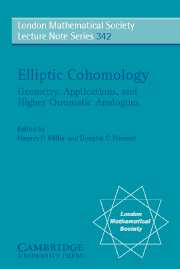Book contents
- Frontmatter
- Contents
- Preface
- Charles Thomas, 1938–2005
- 1 Discrete torsion for the supersingular orbifold sigma genus
- 2 Quaternionic elliptic objects and K3-cohomology
- 3 The M-theory 3-form and E8 gauge theory
- 4 Algebraic groups and equivariant cohomology theories
- 5 Delocalised equivariant elliptic cohomology (with an introduction by Matthew Ando and Haynes Miller)
- 6 On finite resolutions of K(n)-local spheres
- 7 Chromatic phenomena in the algebra of BP*BP-comodules
- 8 Numerical polynomials and endomorphisms of formal group laws
- 9 Thom prospectra for loopgroup representations
- 10 Rational vertex operator algebras
- 11 A possible hierarchy of Morava K-theories
- 12 The motivic Thom isomorphism
- 13 Toward higher chromatic analogs of elliptic cohomology
- 14 What is an elliptic object?
- 15 Spin cobordism, contact structure and the cohomology of p-groups
- 16 Brave New Algebraic Geometry and global derived moduli spaces of ring spectra
- 17 The elliptic genus of a singular variety
10 - Rational vertex operator algebras
Published online by Cambridge University Press: 03 May 2010
- Frontmatter
- Contents
- Preface
- Charles Thomas, 1938–2005
- 1 Discrete torsion for the supersingular orbifold sigma genus
- 2 Quaternionic elliptic objects and K3-cohomology
- 3 The M-theory 3-form and E8 gauge theory
- 4 Algebraic groups and equivariant cohomology theories
- 5 Delocalised equivariant elliptic cohomology (with an introduction by Matthew Ando and Haynes Miller)
- 6 On finite resolutions of K(n)-local spheres
- 7 Chromatic phenomena in the algebra of BP*BP-comodules
- 8 Numerical polynomials and endomorphisms of formal group laws
- 9 Thom prospectra for loopgroup representations
- 10 Rational vertex operator algebras
- 11 A possible hierarchy of Morava K-theories
- 12 The motivic Thom isomorphism
- 13 Toward higher chromatic analogs of elliptic cohomology
- 14 What is an elliptic object?
- 15 Spin cobordism, contact structure and the cohomology of p-groups
- 16 Brave New Algebraic Geometry and global derived moduli spaces of ring spectra
- 17 The elliptic genus of a singular variety
Summary
Abstract. We discuss the foundations of vertex operator algebras and their representations, concentrating on rational vertex operator algebras. We use the Witt-Grothendieck group of conformal field theories as a vehicle to describe results, in particular the connections with modular forms.
INTRODUCTION
Vertex operator algebras suggest themselves as objects that could play a rôle in a geometric description of elliptic cohomology and related topics. As linear spaces with lots of symmetry they can participate in K-theoretic type constructions, and many (but not all) vertex operator algebras are endowed with a natural modular form as part of their structure. The incorporation of vertex operator algebras into topology is well under way (e.g. [Bo], [MS], [MSV], [T]), but it seems true to say that the underlying algebraic theory is not well understood by many potential users of the subject. What follows is an attempt to convey some of the basic ideas about vertex operator algebras, in particular the rapidly advancing theory of rational vertex operator algebras. These are the algebras most naturally associated to modular forms, and in the guise of RCFT (rational conformal field theory) they constitute an active area of research in physics ([FMS]) as well as mathematics. For more information and background the reader may refer to the following: [DM4], [FLM], [G], [K1], [KR], [QFS]. Additional references will be mentioned below.
In my talk at the Newton Institute I emphasized questions about group actions (orbifold theory) and in particular how one can get information about finite group cohomology (e.g., for the Monster group) by looking at maps of equivariant Witt-Grothendieck groups of vertex operator algebras into group cohomology.
- Type
- Chapter
- Information
- Elliptic CohomologyGeometry, Applications, and Higher Chromatic Analogues, pp. 239 - 254Publisher: Cambridge University PressPrint publication year: 2007



